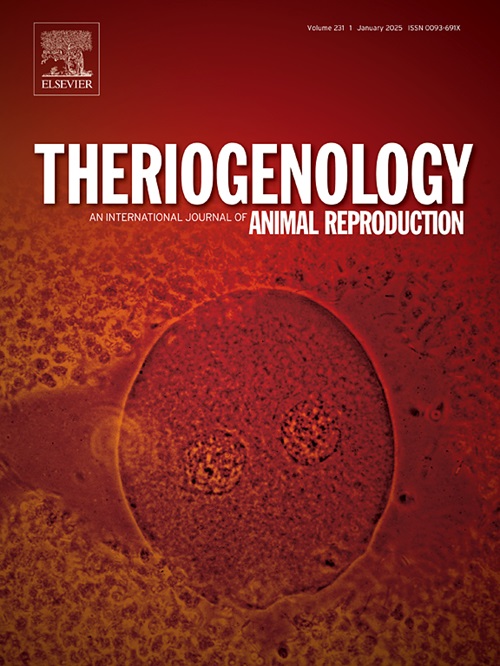Immunohistochemical expression of testin protein in testicular tumours in dogs
IF 2.4
2区 农林科学
Q3 REPRODUCTIVE BIOLOGY
引用次数: 0
Abstract
Testin (TES), a protein localised in the cytoplasm and belonging to the LIM family of proteins, is part of the cytoskeleton localised along stress fibres and recruited to focal adhesions. It is considered a tumour suppressor protein in humans and decreased TES expression has been shown to increase cell motility and decrease cell-cell contact. In veterinary medicine, TES has only been studied in rat testes and, more recently, also in canine testes. The expression of this protein in testicular tumours is unknown. As the dog has been proposed as an animal model for the study of human testicular tumours, studies on canine TES may provide useful information for both species. Therefore, the purpose of the present study was to demonstrate the expression of TES in the most common types of canine testicular tumours. For this study, paraffin blocks of 166 canine testicular tumours (53 Sertoli cell tumours, 50 Leydig cell tumours, and 63 seminomas) were retrieved from the archive of the Department of Pathology of Wroclaw University of Environmental and Life Sciences. Sections were obtained for complete description of the tumours, confirmation of the histological diagnosis, and immunohistochemical TES antigen location. Sections from 10 normal canine testes were examined as controls. The presence of TES was also demonstrated in fresh tissue from three types of canine testicular tumour. The diagnosis was confirmed in the 166 tumours, and TES was immunohistochemically demonstrated in 98 % of them and in all 10 normal testes. All tumour types had reduced expression of TES, even if not related to the tumour growth pattern or mitotic index, demonstrating that TES expression is reduced in canine as well in human testicular tumours. However, the reduction of TES expression appeared to be moderate, and these features were consistent with the evidence that testicular tumours in dogs are often well-differentiated. A complete understanding of the function of TES in cancer processes requires further investigation, but the relative parallelism between normal and neoplastic cells in well-differentiated, mostly benign testicular tumours provides a good basis for studying TES expression in more aggressive tumours, such as prostatic or urinary tract neoplasms.
犬睾丸肿瘤中睾丸蛋白的免疫组化表达
睾丸素(TES)是一种定位于细胞质的蛋白质,属于 LIM 蛋白家族,是细胞骨架的一部分,沿着应力纤维定位于细胞质,并被招募到病灶粘附处。在人类中,它被认为是一种肿瘤抑制蛋白,研究表明,TES 的表达减少会增加细胞的运动性,减少细胞与细胞之间的接触。在兽医学中,TES 只在大鼠睾丸中进行过研究,最近还在犬睾丸中进行了研究。这种蛋白质在睾丸肿瘤中的表达情况尚不清楚。由于狗已被提议作为研究人类睾丸肿瘤的动物模型,因此对犬睾丸TES的研究可能会为这两个物种提供有用的信息。因此,本研究旨在证明 TES 在最常见类型犬睾丸肿瘤中的表达。本研究从弗罗茨瓦夫环境与生命科学大学病理学系的档案中获取了 166 个犬睾丸肿瘤(53 个 Sertoli 细胞肿瘤、50 个 Leydig 细胞肿瘤和 63 个精原细胞瘤)的石蜡块。获取的切片用于完整描述肿瘤、确认组织学诊断和免疫组化 TES 抗原定位。10 个正常犬睾丸的切片作为对照。三种犬睾丸肿瘤的新鲜组织也证明了 TES 的存在。166 个肿瘤均得到确诊,其中 98% 的肿瘤和所有 10 个正常睾丸均通过免疫组织化学方法证实了 TES 的存在。所有类型的肿瘤都有 TES 表达减少的现象,即使与肿瘤生长模式或有丝分裂指数无关。不过,TES表达的减少似乎是适度的,这些特征与狗的睾丸肿瘤通常分化良好的证据相一致。要完全了解 TES 在癌症过程中的功能还需要进一步研究,但在分化良好且多为良性的睾丸肿瘤中,正常细胞和肿瘤细胞之间的相对平行性为研究 TES 在更具侵袭性的肿瘤(如前列腺或尿路肿瘤)中的表达提供了良好的基础。
本文章由计算机程序翻译,如有差异,请以英文原文为准。
求助全文
约1分钟内获得全文
求助全文
来源期刊

Theriogenology
农林科学-生殖生物学
CiteScore
5.50
自引率
14.30%
发文量
387
审稿时长
72 days
期刊介绍:
Theriogenology provides an international forum for researchers, clinicians, and industry professionals in animal reproductive biology. This acclaimed journal publishes articles on a wide range of topics in reproductive and developmental biology, of domestic mammal, avian, and aquatic species as well as wild species which are the object of veterinary care in research or conservation programs.
 求助内容:
求助内容: 应助结果提醒方式:
应助结果提醒方式:


